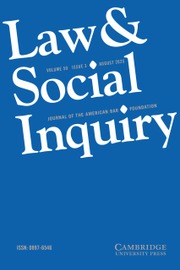No CrossRef data available.
Article contents
Judicial Populism and Corruption Prosecutions in the Mani Pulite Operation
Published online by Cambridge University Press: 15 October 2024
Abstract
I provide a new analytical framework to understand the effectiveness of corruption prosecutions in the so-called Mani Pulite (Clean Hands) operation by showing how this operation was rooted in a populist interpretation of criminal rules and criminal procedure. The Clean Hands operation represented a successful breakthrough against the vast and complex corruption system that had sustained Italian politics for decades. I show that prosecutors in the Clean Hands operation interpreted legal rules through the lens of a deep-seated hostility between a vague conglomerate of “corrupt elites” and “virtuous citizens.” This populist interpretation of criminal and procedural rules introduced significant legal innovations that empowered judicial actors against systemic corruption by creating unprecedented incentives for defendants to cooperate with legal authorities. Consequently, the judicial professionals leading the Clean Hands operation also felt the need to shield themselves against retaliation for the use of these novel approaches to corruption prosecution by bringing their fight before the court of public opinion. To this end, the Clean Hands prosecutors made use of targeted media interventions to rally public support around their investigation and protect their work from political interference.
- Type
- Articles
- Information
- Copyright
- © The Author(s), 2024. Published by Cambridge University Press on behalf of American Bar Foundation
Footnotes
Previous versions of this article were presented at the Law and Society Association’s 2022 annual meeting, at the American Political Science Association’s 2022 annual meeting, and at a workshop on ATI and transparency in qualitative research in 2022. I am thankful to the workshop participants and the panel discussants at both conferences, especially Fábio De Sá e Silva, who provided comments and suggestions on this article. I am particularly thankful to Lisa Hilbink and Yasser Kureshi for inviting me to contribute to the idea of judicial populism through my research and to Rafael Mafei Rabelo Queiroz, Anuj Bhuwania, Rohit De, and Ezequiel González Ocantos for helping me think through this issue. I am also grateful to Fernando Bizzarro for his incredibly helpful feedback on an earlier version of the article. I owe an immense debt of gratitude to Lisa Hilbink for her incredible support and exceptional mentorship throughout this project and beyond. Finally, I am thankful to the anonymous reviewer for their helpful feedback on this article.


